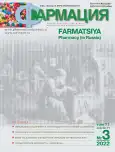Qualitative and quantitative analysis of the main psoralen derivatives in the juice of Sosnowsky's hogweed
- 作者: Ageev V.P.1, Shlyapkina V.I.1, Kulikov O.A.1, Zaborovskiy A.V.2, Tararina L.A.2
-
隶属关系:
- Federal State Budgetary Educational Institution of Higher Education «National Research Ogarev Mordovia State University»
- Federal State Budgetary Educational Institution of Higher Education "A.I. Yevdokimov Moscow State University of Medicine and Dentistry" of the Ministry of Healthcare of the Russian Federation
- 期: 卷 71, 编号 3 (2022)
- 页面: 10-17
- 栏目: Articles
- URL: https://bakhtiniada.ru/0367-3014/article/view/143990
- DOI: https://doi.org/10.29296/25419218-2022-03-02
- ID: 143990
如何引用文章
详细
Introduction. Sosnovsky's hogweed is a dangerous weed and has a pronounced photosensitizing effect. The photosensitizing effect of hogweed is conditioned to the presence of furanocoumarins in all parts of the plant. Due to its large biomass, fast growth rate, and unpretentiousness to natural conditions, it is promising as a medicinal plant material suitable for the production of photosensitizers for PUVA therapy. Objective: to conduct a qualitative and quantitative determination of psoralen derivatives in the juice of Sosnowsky's hogweed. Material and methods. For the study, wild-growing samples of raw materials were used. Raw materials of Sosnowsky's hogweed were harvested during the flowering period of the plant. To study the content of furanocoumarins in hogweed Sosnowski, juice obtained from the aerial part of the plant was used. The juice was subjected to extraction with chloroform. Purification and separation of the extract were carried out using gradient column chromatography. The extract fractions were subjected to qualitative and quantitative analysis using thin layer chromatography, spectrophotometry, NMR spectroscopy and HPLC. Results. 6 main fractions were obtained during column chromatography of Sosnowsky's hogweed juice extract. The fraction of the extract richest in furanocoumarins was obtained. According to thin-layer chromatography, spectrophotometry and NMR-spectroscopy, the main furanocoumarins of Sosnowsky's hogweed juice are psoralen derivatives. According to HPLC data, the content of 8-methoxypsoralen in the juice of Sosnowsky's hogweed was 1.332 g/l, and 5-methoxypsoralen was 0.034 g/l. Conclusion. Raw materials of Sosnowsky's hogweed can be a source of furanocoumarins for the needs of pharmacy, and the methods of analysis presented in the study can form the basis of its standardization. The Sosnowsky's hogweed, having become a wild-growing source of medicinal raw materials, can be subjected to regular harvesting, which can reduce the area of its distribution.
作者简介
Valentin Ageev
Federal State Budgetary Educational Institution of Higher Education «National Research Ogarev Mordovia State University»
编辑信件的主要联系方式.
Email: valeageev@yandex.ru
junior researcher, laboratory of pharmacokinetics and targeted pharmacotherapy
Vasilisa Shlyapkina
Federal State Budgetary Educational Institution of Higher Education «National Research Ogarev Mordovia State University»
Email: shlyapkina.98@mail.ru
PhD student of the department of pharmacology and clinical pharmacology with the course of pharmaceutical technology
Oleg Kulikov
Federal State Budgetary Educational Institution of Higher Education «National Research Ogarev Mordovia State University»
Email: oleg-kulikov-84@mail.ru
Doctor of Medicine, associate professor of the department of pharmacology and clinical pharmacology with the course of pharmaceutical technology
Andrey Zaborovskiy
Federal State Budgetary Educational Institution of Higher Education "A.I. Yevdokimov Moscow State University of Medicine and Dentistry" of the Ministry of Healthcare of the Russian Federation
Email: azabor@mail.ru
Doctor of Medicine, associate professor, Head of the department of pharmacology
Larisa Tararina
Federal State Budgetary Educational Institution of Higher Education "A.I. Yevdokimov Moscow State University of Medicine and Dentistry" of the Ministry of Healthcare of the Russian Federation
Email: 79104906528@yandex.ru
senior lecturer of department of pharmacology
参考
- Nielsen C., Ravn H.P., Nentwig W. and Wade M. (eds.). The Giant Hogweed Best Practice Manual. Guidelines for the management and control of an invasive weed in Europe. Forest & Landscape Denmark, Hoersholm. 2005; 44.
- Куценко В.П., Ковалева Д.Д., Миронова Н.Р., Леденцова С.С., Безвуляк Е.И., Селиверстов П.В., Борщевик Сосновского и фотохимический дерматит. Медицинская сестра. 2022; 24 (3): 19-22. DOI: https://doi.org/10.29296/25879979-2022-03-03
- Wang C.-C., Wang Y.-X., Yu N.-Q. et al. Brazilian Green Propolis Extract Synergizes with Protoporphyrin IX-mediated Photodynamic Therapy via Enhancement of Intracellular Accumulation of Protoporphyrin IX and Attenuation of NF-kB and COX-2. Molecules. 2017; 22 (5): 732. doi: 10.3390/mole-cules22050732
- Lin H.-J., Ho J.-H., Tsai L.-C. et al., Synthesis and In Vitro Photocytotoxicity of 9-/13-Lipophilic Substituted Berberine Derivatives as Potential Anticancer Agents. Molecules. 2020; 25 (3): 677. doi: 10.3390/mole-cules25030677
- Mazur Y., Lavie G., 2001. Heliantrone derivatives as anticancer agents. US 6,229,048 B1. Assignees: Yeda Research and Development Co. Ltd. at the Weizmann Institute of Science, Rehovot (IL); New York University, New York, NY (US).
- Bartnik, M., Mazurek, A.K., Isolation of methoxyfurano-coumarins from Ammimajus by centrifugal partition chromatography. J. Chromatogr. Sci. 2016; 54 (1): 10-6. DOI: 10.1093/ chromsci/bmv098.
- Fathallah N., Raafat M.M., Issa M.Y. et al., Bio-Guided Fractionation of Prenylated Benzaldehyde Derivatives as Potent Antimicrobial and Anti biofilm from Ammi majus L. Fruits-Associated Aspergillus amstelodami. Molecules. 2019; 24 (22): 4118. doi: 10.3390/molecules24224118.
- Bruni R., Barreca D., Protti M. et al., Botanical Sources, Chemistry, Analysis, and Biological Activity of Furanocoumarins of Pharmaceutical Interest. Molecules. 2019; 24 (11): 2163. doi: 10.3390/molecules24112163
- Аndreevа L.V., Sosnowsky hogweed: new ways to use. BAICSEM IOP Conf. Series: Earth and Environmental Science. 2020; 613: 012006. doi: 10.1088/1755-1315/613/1/0120062
- Tkachenko K., Heteromericarpy of Heracleum sosnow-skyi Manden. (Umbelliferae = Apiaceae). Proceedings on applied botany, genetics and breeding. 2021; 181: 156-63. doi: 10.30901/2227-8834-2020-4-156-163.
- Dehghan H., Sarrafi Y., Salehi P. et al., a-Glucosidase inhibitory and antioxidant activity of furanocoumarins from Heracleum persicum. Med. Chem. Res. 2017; 26: 849-55. doi: 10.1007/s00044-017-1796-y
- Vandermolen K.M., Cech N.B., Paine M.F. et al., Rapid quantitation of furanocoumarins and flavonoids in grapefruit juice using ultra-performance liquid chromatography. Phytochem. Anal. 2013; 24: 654-60. doi: 10.1002/pca.2449.
- Fulmer G.R., Miller A.J.M., Sherden N.H. et al. NMR Chemical shifts of trace impurities: common laboratory solvents, organics, and gases in deuterated solvents relevant to the orga-nometallic chemist. Organometallics. 2010; 29: 2176-9. doi: 10.1021/om100106e.
- Wagner H., Bladt S., Plant drug analysis. A thin layer chromatography atlas. Second edition. Springer, USA. 1996; 384. doi: 10.1007/978-3-642-00574-9.
- He F., Wang M., Gao M. et al., Chemical composition and biological activities of Gerbera anandria. Molecules. 2014; 19 (4): 4046-57. doi: 10.3390/molecules19044046
补充文件













